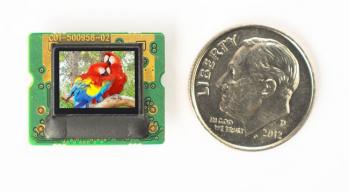Wearable OLEDs - Introduction and Latest Industry News - Page 14
The Asus ZenWatch 3 AMOLED smartwatch is now shipping
Asus' 3rd-gen ZenWatch is now shipping for $225. The ZenWatch 3 is an Android Wear smartwatch that features a 1.39" 400x400 (287 PPI) AMOLED display, a SnapDragon Wear 2100 CPU, 512MB of RAM and 4GB of storage.
The Fraunhofer FEP now offers development kits based on bi-directional OLED microdisplays
In March 2015 the Fraunhofer FEP demonstrated its second-generation bi-directional OLED microdisplays, with a resolution of 800x600 (SVGA), up from VGA in the first generation first unveiled in 2012.

The Fraunhofer is now making a new development platform of these bi-directional eyeglasses, based on the new microdisplays, available to clients creating proprietary products. The updated platform has a new hardware design with standard HDMI and USB interfaces. The new eyeglasses were developed as part of the FAIR project, funded by the German Federal Ministry of Education and Research (BMBF).
Apple announces the Watch Series 2 and the iPhone 7
Yesterday Apple announced two new devices - the iPhone 7 (and 7 Plus) and the new Watch Series 2. The new Watch is Apple's 2nd-Generation smartwatch that has several improvements over the first generation - including a built-in GPS, waterproofing and better hardware.

We're mostly interested in the display, of course, and the Watch 2 display features the same size and resolution as the first generation - either 272x340 38mm or 312x390 42mm. The main improvement in the new display is that it is twice as bright at 1,000 nits (the original Watch's display had 450 nits).
Innolux to ship its first OLED displays in 2017
Last week Innolux demonstrated new rigid and flexible AMOLED prototypes, and the company says it aims to mass produce AMOLEDs. The company's VP Jeffrey Yang says that the company will be able to ship its first AMOLEDs in 2017, and these will be small displays for wearable devices. The company aims to ship automotive OLEDs starting in 2020.
Innolux's CEO says that Taiwanese companies find it hard to compete with Korean and Chinese display makers because the government of Taiwan does not provide enough financial support. Some reports say that Innolux aims to integrate Innolux's and Sharp's OLED units.
RitDisplay expects growth ahead in the PMOLED market
RitDisplay's president and CEO, D.C. Wang, sees growth ahead in the PMOLED market. RitDisplay expects revenues to grow more than 20% in the second half of 2016, up from almost $32 in the first half.

In order to meet the expected demand (mostly from wearable devices, it seems), RiTDisplays aims to grow its capacity by 20 to 40 percent in 2017. Earlier reports suggested that the capacity increase will come from more efficient production ("deleting bottlenecks") - not from new equipment.
eMagin reports its Q2 2016 results, excited about its consumer and commercial opportunities
OLED microdisplay maker eMagin reports its financial results for Q2 2016. This was a financially challenging quarter for eMagin, but the company says it is excited about its progress on opportunities in the commercial and consumer markets. Revenues were $5.5 million (down 21% compared to Q2 2015 - mostly due to lower volumes and manufacturing issues that has been resolved). Net loss was $2.2 million (up from $66,000 in Q2 2015).
 eMagin XGA096 OLED-XL
eMagin XGA096 OLED-XL
At the end of the quarter, eMagin had $6.1 million in cash and equivalents (down from $9.3 million at the end of 2015). The company increased its R&D investments and began to build inventory as it expects to launch two consumer products later this year (more on these below). eMagin expanded its active customer count by 11% since the beginning of 2016 - and it currently has 108 active customers.
Razer to ship the OSVR HDK2 VR HMD on July 29
Razer announced that it will ship the OSVR HDK2 on July 29. The basic configuration (available for pre-order now) costs $399.
The HDK2, which is based on an open-source software platform, uses a 2160x1200 low-persistence (90fps) AMOLED display.
China's Deepoon starts shipping its M2 OLED VR system
DeePoon started shipping its M2 VR headset a few weeks ago. The company says the orders (since announcing the M2 in April 2016) are over 20,000 already - which makes this HMD the most successful one in China's VR headset industry.

The M2 includes an on-device computer using Samsung's Exynos 7420 chipset. The M2's display is a 2560x1440 AMOLED display made by SDC. Deepon operates what it says to be the largest VR content platform in China with over 150 VR games and 5 million users.
Everdisplay unveiles the specification of its latest wearable AMOLEDs
A few weeks ago Everdisplay demonstrated several AMOLED prototypes, including some new displays such as a 0.95" square AMOLED and a 1.2" circular one.
In a recent tradeshow, Everdisplay demonstrated these new displays, but now the company unveiled the specifications of its new panels. The 0.95" square AMOLED features a resolution of 180x120 (228 PPI), a thickness of 0.5 mm and a luminance of 350 nits. The 1.2" circular panel is 390x390 (326 PPI), 0.4 mm thick and with the same luminance of 350 nits.
Will Apple use a Micro-LED panel in its 2017 Watch?
The first-generation Apple Watch uses a flexible OLED display, exclusively produced by LG Display. Digitimes now says that Apple is developing a Micro-LED panel to be used in a future Watch - to be released in H2 2017.

Apple acquired Micro-LED developer LuxVuew in May 2014, and according to this report has setup a micro-LED research lab in Taiwan in 2015.
Pagination
- Previous page
- Page 14
- Next page






